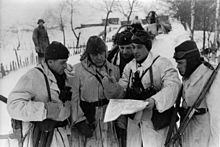This is an old revision of this page, as edited by Khazar2 (talk | contribs) at 02:52, 27 June 2013 (removing POV tag with no active discussion per Template:POV). The present address (URL) is a permanent link to this revision, which may differ significantly from the current revision.
Revision as of 02:52, 27 June 2013 by Khazar2 (talk | contribs) (removing POV tag with no active discussion per Template:POV)(diff) ← Previous revision | Latest revision (diff) | Newer revision → (diff)| This article may require cleanup to meet Misplaced Pages's quality standards. No cleanup reason has been specified. Please help improve this article if you can. (June 2009) (Learn how and when to remove this message) |
| Latvian Auxiliary Police | |
|---|---|
 Members of the 21st Latvian Police Battalion assemble a group of Jewish women for execution on a beach near Liepaja, December 15, 1941. Members of the 21st Latvian Police Battalion assemble a group of Jewish women for execution on a beach near Liepaja, December 15, 1941. | |
| Active | from July 1941 |
| Country | |
| Engagements | Holocaust in Latvia, Anti-partisan operations in Belarus |
| Commanders | |
| Notable commanders | Viktors Arājs Roberts Blūzmanis |
Latvian Auxiliary Police was a paramilitary force created from Latvian volunteers by the Nazi German authorities who occupied the country in June 1941. Composed of local fascists, rightist members of the former military and police, and nationalist students, the organization participated in the Holocaust, looting and killing the local Jewish population. One of its units, the Arajs Kommando, was notorious for killing 26,000 civilians during the war, mostly Jews, but also Communists and Romas.
Formation of units
The auxiliary police force consisted primarily individuals of police, army, and militia organizations which had been disbanded upon the prior Soviet occupation. Within the first week of the German occupation, the leader of Einsatzgruppe A Franz Walter Stahlecker tasked Lt. Colonel Voldemārs Veiss with organising a police force to operate under the command of the SS.
The first Latvian Schutzmannschaft (Police) Battalions were formed, most to serve as combat units, some to carry out raids against partisans and to discharge ghetto guard duties. One of the earliest units formed was in Daugavpils, which German forces reached on June 28, 1941, six days after launching Operation Barbarossa. Roberts Blūzmanis was appointed chief of the Latvian Auxiliary Police in Nazi-occupied Daugavpils. An auxiliary police force was in Riga under Nazi ausipces on July 3, 1941, headed by Latvian captain, Pētersons.

Organization
Owing to the initiative of the EK (Einsatzkommando), the auxiliary police force consisted of 240 men and had been strictly organized. New men were currently being enlisted. They helped the EK as auxiliary police and were on duty in the 6 police districts established so far. Some members had been assigned to Kriminalpolizei and Sicherheitspolizei work. By July 7 the Latvians arrested 1125 Jews, 32 political prisoners, 85 Russian workers, and 2 women criminals, the greater part during the last days. This is due to the EK backing the Latvians. Actions against the Jews were going on in an ever-increasing number. Conforming to a suggestion of the EK, the Jews were being evacuated by the auxiliary police force from all houses still standing. The apartments were being allocated to non-Jewish inhabitants. The food supply was inadequate as nearly all stocks were destroyed by fire. The arrested Jewish men were shot without ceremony and interred in previously prepared mass graves. 400 Jews were killed during pogroms in Riga, since the arrival of EK 2; 300 by the Latvian auxiliary police. By 1944, the occupation power, with the collaboration of the Self-Administration, had formed a total of 33 auxiliary police battalions.
The Arajs Kommando (also: Sonderkommando Arajs), led by SS-Sturmbannführer Viktors Arājs, was a unit of Latvian Auxiliary Police (Template:Lang-de) subordinated to the SD. It is one of the more well-known and notorious killing units during the Holocaust. The central part of Andrew Ezergailis' work details the activities of the Arajs Kommando, the Latvian unit that Brigadeführer Franz Walter Stahlecker organized for the killing of the Jews of Latvia. Numerous Latvian auxiliary police units played a major role in the murdering the Jews.
See also
References
Citations
- Michael Mann, The dark side of democracy: explaining ethnic cleansing. Cambridge University Press, 2005. ISBN 0-521-53854-8. p. 283
- Lumens (2006). p266.
- Nazi Conspiracy and Aggression Volume 1. Chapter XII - The Persecution of the Jews
- Jacob Gorfinkel, Daugavpils (Dvinsk) Ghetto List – 05-December-1941
- Andrew Ezergailis, The Holocaust in Latvia
Bibliography
- Lumans, Valdis O. (2006). Latvia in World War II. Fordham Univ Press. ISBN 978-0-8232-2627-6.
| Einsatzgruppen and Einsatzkommandos | |||||||||||||||||
|---|---|---|---|---|---|---|---|---|---|---|---|---|---|---|---|---|---|
| People |
| ||||||||||||||||
| Groups |
| ||||||||||||||||
| Crimes |
| ||||||||||||||||
| Records | |||||||||||||||||
| The Holocaust in Latvia | |
|---|---|
| Crimes | |
| Victims | |
| Perpetrators |
|
| Nazi occupation and organizations | |
| Collaborators |
|
| Ghettos and camps | |
| Documentation | |
| Concealment | |
| War crimes investigations and trials | |
| Righteous Among the Nations | |
| Memorials | |
| Related articles | |
- Articles needing cleanup from June 2009
- Cleanup tagged articles without a reason field from June 2009
- Misplaced Pages pages needing cleanup from June 2009
- Latvian collaborators with Nazi Germany
- Collaboration during World War II
- Collaborators during World War II occupations
- Collaborators with Nazi Germany
- Defunct law enforcement agencies of Germany
- History of Latvia
- Law enforcement units
- Military history of Germany during World War II
- The Holocaust in Latvia
- The Holocaust in Belarus
- Local participation in the Holocaust
- Einsatzgruppen